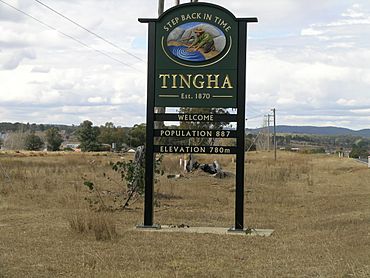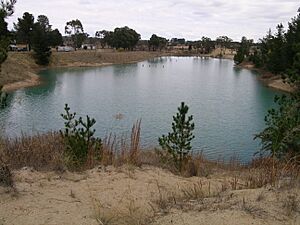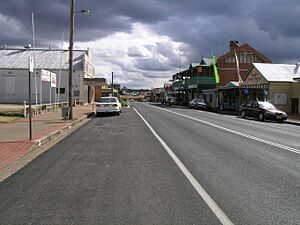Tingha, New South Wales facts for kids
Quick facts for kids TinghaNew South Wales |
|
|---|---|

Tingha entry sign
|
|
| Population | 833 (2021 census) |
| Established | 1885 |
| Postcode(s) | 2369 |
| Elevation | 780 m (2,559 ft) |
| Location | |
| LGA(s) | Inverell Shire |
| County | Hardinge |
| State electorate(s) | Northern Tablelands |
| Federal Division(s) | New England |
Tingha is a small town located in the Northern Tablelands, New South Wales, Australia. It is part of the Inverell Shire area. The town is about 30 kilometres (19 miles) south of Inverell and 559 kilometres (347 miles) north-north-east of Sydney. The name "Tingha" comes from an Aboriginal word meaning "flat or level."
Contents
The History of Tingha
Before European settlers arrived, the land where Tingha now stands was home to the Nucoorilma clan. These people were part of the Gamilaroi Nation, a group of the Murri Aboriginal people. Many of their family members still live in the area today.
How Tingha Began
Tingha was first settled in 1841 by Sydney Hudson Darby. It became a busy mining town after tin was found there in the 1870s. Within a year, Australia's first commercial tin mines started working. About 5,000 people moved to the area, and around 1,000 of them were Chinese miners. The Wing Hing Long Museum, which was a general store run by a Chinese storekeeper named Ah Lin in the 1880s, reminds us of this history.
The local Post Office opened in September 1872 and was first called Armidale Crossing. It was renamed Tingha the very next month.
Growth and Challenges
The village was officially declared a town in 1885. At first, there was plenty of tin close to the surface. This made it easy for miners, especially Chinese miners, to find tin without needing big machines. The first school in Tingha was opened in 1890 by the Sisters of St. Joseph.
However, a drought hit the area in the 1890s. Also, the easily found tin ran out. This caused many people to leave, and the town's population went down.
By the early 1900s, the big tin mining rush was over. Tingha's population had shrunk to only a few hundred people. After this, larger companies moved in to mine the tin that was harder to reach. They used special machines called dredges for their mining work.
Changes in Local Government
Tingha used to be part of the Guyra Shire and then the Armidale Region. But on 1 July 2019, the responsibility for Tingha was moved. It is now looked after by the Inverell Shire Council.
Special Places in Tingha
Tingha has some places that are important for their history. These are called heritage-listed sites.
- 10 Ruby Street: Wing Hing Long & Co. Store
Tingha Today
Today, the main work in Tingha is farming. Some people also enjoy looking for minerals, which is called fossicking. Tin mining still happens, but how much depends on the price of tin around the world.
Town Facilities
Tingha has many services for its residents and visitors. It has a hospital, a pre-school, and a primary school. There is also a caravan park, a sports and recreation club, and a first aid post. You can find hotels and other shops for daily needs.
The Tingha Tigers rugby league club is very popular. Several players from this club have gone on to play in the National Rugby League, which is a big professional sports league.
Fun Things to Do
Tingha has a "swimming hole," which is a large pool made from an old mining hole. One of the main attractions near Tingha is the "Green Valley Farm" Entertainment Park. In 2018, the people of Tingha voted for their town to become part of the Inverell Shire Council area.
Recent Events
In February 2019, a bushfire started by a lightning strike affected the area. The fire burned a large area of land and unfortunately destroyed 13 homes and 44 other buildings. Six more homes and 13 other buildings were also damaged.
Famous People from Tingha
Several talented rugby league players have connections to Tingha:
- Nathan Blacklock – a former player for the Kangaroos, St George Illawarra Dragons, and Hull F.C.. He also played rugby union for the Waratahs.
- Preston Campbell – a former player for the Gold Coast Titans, Cronulla Sharks, Penrith Panthers, and Gold Coast Chargers.
- Owen Craigie – a former player for the Newcastle Knights, Wests Tigers, South Sydney Rabbitohs, and Widnes.
- Bevan French – a former player for the Parramatta Eels who played junior rugby league for the Tingha Tigers. He now plays in England for the Wigan Warriors.
- Chris Lewis – a player for the Melbourne Storm who played junior rugby league for the Ashford Roosters.
| Historical population | ||
|---|---|---|
| Year | Pop. | ±% |
| 1966 | 272 | — |
| 1971 | 259 | −4.8% |
| 1976 | 868 | +235.1% |
| 1981 | 886 | +2.1% |
| 1986 | 837 | −5.5% |
| 1991 | 831 | −0.7% |
| 1996 | 732 | −11.9% |
| 2001 | 707 | −3.4% |
| 2006 | 713 | +0.8% |
| 2011 | 527 | −26.1% |
| 2016 | 476 | −9.7% |
| 2021 | 445 | −6.5% |
| Source: Australian Bureau of Statistics data. | ||




